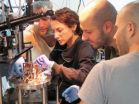(Press-News.org) Is cancer an inevitable consequence of aging?
Although it is widely thought that cancer is an inevitable consequence of aging, the risk of developing several common cancers decreases with age.
Researchers have long been puzzled by the apparent decrease with age in the risk of developing certain adult cancers.
A possible solution to this puzzle was presented in a recent paper published in Biophysical Reviews and Letters by Professor James P. Brody of the Department of Biomedical Engineering at the University of California, Irvine.
"Most cancers have a characteristic age at which they occur. Testicular cancers mostly occur from age 25-40, bone sarcomas in the teens. Beyond the characteristic age, the incidence of these cancers decreases. Several common cancers appear to have a characteristic age greater than the typical lifespan. Observations of these cancers have led to the belief that the incidence of these cancer increases without limit.
However I believe that we just don't see the decrease of the incidence for some common forms of cancer because people don't live long enough to see it.
One possible explanation is that many cancers originate early in life, possibly before birth. This is called the developmental origin of disease hypothesis. If true, this suggests that a test could be developed that would determine whether a person might develop a specific form of cancer decades before they actually develop it.
Ultimately this test would lead to earlier diagnosis and preventing many forms of cancer from ever developing to the life threatening stage.
Cancer research has three general focal points: how can we diagnose tumors earlier, how can we treat cancer patients to prolong and enhance their lives, and how do tumors originate. This work provides insight into how cancers originate and it may ultimately lead to an understanding of how to reduce the number of cancer patients.
INFORMATION:
The paper can be found in the Biophysical Reviews and Letters journal.
Cancer is avoidable as you grow older. Here's how.
2014-07-14
ELSE PRESS RELEASES FROM THIS DATE:
Manuel Serrano proposes a new vision of a process wrongly associated with ageing
2014-07-14
For the Spanish Royal Academy, senescent is he who "begins to age". But laboratory biology results are contradicting the dictionary: not only is senescence not a synonym of ageing, it is also not intrinsically negative for the organism. Cellular senescence is such a badly named physiological process that those who do research in this area think it needs another name. That is the case of Manuel Serrano, from the Spanish National Cancer Research Centre (CNIO), one of the world's leading experts on senescence, who has just published a review on this topic. Without actually ...
Validity of change in DSM-5 ADHD age of onset criterion confirmed
2014-07-14
Washington D.C., July 14, 2014 – A recent study published in the July 2014 issue of the Journal of the American Academy of Child and Adolescent Psychiatry confirms the validity of the DSM-5 change to the age of onset criterion for diagnosis of attention-deficit/hyperactivity disorder (ADHD).
In DSM-5, age of onset criterion for ADHD, previously set at 7 in DSM-IV, has been raised to 12. As explained in DSM-5, age of onset is now set at 12, rather than an earlier age, to reflect the importance of clinical presentation during childhood for accurate diagnosis, while also ...
'Noisy' memory in schizophrenia
2014-07-14
Philadelphia, PA, July 14, 2014 – The inability to ignore irrelevant stimuli underlies the impaired working memory and cognition often experienced by individuals diagnosed with schizophrenia, reports a new study in the current issue of Biological Psychiatry.
Our brains are usually good at focusing on the information that we are trying to learn and filtering out the "noise" or thoughts that aren't relevant. However, memory impairment in schizophrenia may be related in part to a problem with this filtering process, which Dr. Teal Eich at Columbia University and her colleagues ...
Flashes of light on the superconductor
2014-07-14
Superconductors are futuristic materials that will hopefully have a broad range of technological applications at some time in the future (medical imaging, transport…). Today's use is limited by the extremely low temperatures (close to absolute zero) required for superconductivity to manifest. However, some families of these materials work at "relatively" high temperatures (about - 200° C), and it's on these that scientists are focusing their attention. Among them are copper-based superconductors, which have very unique characteristics. A study conducted by researchers of ...
New theory turns cancer on its head
2014-07-14
A new theory of how cancer works could lead to the next generation of treatments of the disease.
The theory suggests that cancer forms when recently evolved genes are damaged, and cells have to revert to using older, inappropriate genetic pathways.
Astrobiologists Dr Charley Lineweaver from The Australian National University and Professor Paul Davies from Arizona State University teamed up with oncologist Dr Mark Vincent from the University of Western Ontario to develop the new model.
"The rapid proliferation of cancer cells is an ancient, default capability that ...
3D printed anatomy to mark a new era for medical training
2014-07-14
The creators of a unique kit containing anatomical body parts produced by 3D printing say it will revolutionise medical education and training, especially in countries where cadaver use is problematical.
The '3D Printed Anatomy Series', developed by experts from Monash University, is thought to be the first commercially available resource of its kind. The kit contains no human tissue, yet it provides all the major parts of the body required to teach anatomy of the limbs, chest, abdomen, head and neck.
Professor Paul McMenamin, Director of the University's Centre for ...
Physical fitness associated with less pronounced effect of sedentary behavior
2014-07-14
ATLANTA – July 14, 2014 –Physical fitness may buffer some of the adverse health effects of too much sitting, according to a new study by researchers from the American Cancer Society, The Cooper Institute, and the University of Texas. The study appears in the journal Mayo Clinic Proceedings, and finds the association between prolonged sedentary time and obesity and blood markers associated with cardiovascular disease is markedly less pronounced when taking fitness into account.
Sedentary behavior has been linked to an increase risk of obesity, metabolic syndrome, type ...
Domestication syndrome: White patches, baby faces and tameness
2014-07-14
More than 140 years ago, Charles Darwin noticed something peculiar about domesticated mammals. Compared to their wild ancestors, domestic species are more tame, and they also tend to display a suite of other characteristic features, including floppier ears, patches of white fur, and more juvenile faces with smaller jaws. Since Darwin's observations, the explanation for this pattern has proved elusive, but now, in a Perspectives article published in the journal GENETICS, a new hypothesis has been proposed that could explain why breeding for tameness causes changes in such ...
UEA research reveals how cannabis compound could slow tumour growth
2014-07-14
Scientists at the University of East Anglia have shown how the main psychoactive ingredient in cannabis could reduce tumor growth in cancer patients.
Research published today reveals the existence of previously unknown signaling platforms which are responsible for the drug's success in shrinking tumours.
It is hoped that the findings could help develop a synthetic equivalent with anti-cancer properties.
The research was co-led with the Universidad Complutense de Madridin, Spain. The team used samples of human breast cancer cells to induce tumours in mice. They ...
The world's first photonic router
2014-07-14
Weizmann Institute scientists have demonstrated for the first time a photonic router – a quantum device based on a single atom that enables routing of single photons by single photons. This achievement, as reported in Science magazine, is another step toward overcoming the difficulties in building quantum computers.
At the core of the device is an atom that can switch between two states. The state is set just by sending a single particle of light – or photon – from the right or the left via an optical fiber. The atom, in response, then reflects or transmits the next incoming ...



